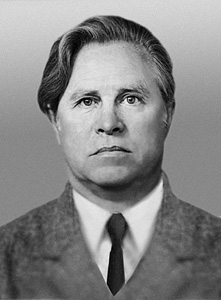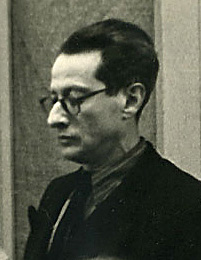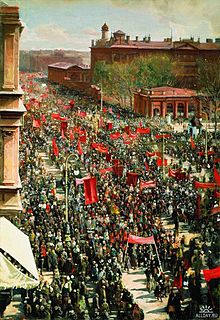
Arkhip Ivanovich Kuindzhi was a Russian landscape painter of Pontic Greek descent.
Events from the year 1959 in art.

Arkady Alexandrovich Rylov was a Russian and Soviet Symbolist painter.

Arkady Alexandrovich Plastov was a Russian socialist realist painter.
Evgeniy Vasilievich Chuikov was a Ukrainian landscape painter working in the Russian realist and French Impressionist traditions.

Nikolai Efimovich Timkov was a Soviet Russian painter, Honored Artist of Russian Federation, and a member of the Saint Petersburg Union of Artists. He lived and worked in Leningrad and is regarded as one of the leading representatives of the Leningrad School of Painting, worldwide known for his landscape paintings.

Gleb Alexandrovich Savinov was a Soviet, Russian painter and Art teacher, Honored Artist of Russian Federation, who lived and worked in Leningrad and regarded as one of the leading representatives of the Leningrad school of painting, most famous for his genre and portrait painting.

Mikhail Georgievich Kozell was a Soviet Russian painter and Art teacher, who lived and worked in Leningrad, and who belonged to the Leningrad School of Painting, most famous for his landscape painting.

Samuil Grigorievich Nevelshtein - Soviet, Russian painter, watercolorist, graphic artist, and art teacher, lived and worked in Leningrad, regarded as one of the representatives of the Leningrad school of painting, most known for his portraits of children and youth.

Alexander Vladimirovich Shmidt was a Russian-Soviet realist painter, graphic artist, and Art teacher who lived and worked in Leningrad. He was a member of the Leningrad Union of Artists, regarded as one of representatives of the Leningrad School of Painting.

Piotr Konstantinovich Vasiliev was a Russian Soviet realist painter, who lived and worked in Leningrad. He was a member of the Leningrad Union of Artists and regarded as one of representatives of the Leningrad school of painting.

Soviet art is a form of visual art that was produced after the October Socialist Revolution of 1917 in Soviet Russia (1917—1922) and the Soviet Union (1922—1991).
The year 1923 was marked by many events that left an imprint on the history of Soviet and Russian Fine Arts.
The year 1931 was marked by many events that left an imprint on the history of Soviet and Russian Fine Arts.
The year 1939 was marked by many events that left an imprint on the history of Soviet and Russian fine arts.

Czeslaw Viktorovich Znamierowski was a renowned Soviet Lithuanian painter, a member of the Artists' Union of the USSR, known for his large artworks and love of nature. Znamierowski combined these two passions to create some of the most notable paintings in the Soviet Union, earning a prestigious title of "Honorable Artist of LSSR" in 1965. His works can be found in the Lithuanian Art Museum, Šiaulių „Aušros“ Museum, Warsaw National Gallery of Art, the Tretyakov Gallery as well as in known private collections and art funds.
The Fine Arts of Leningrad retrospective exhibition became the largest showing of Leningrad artists in the Soviet History outside the city, as well as in total one of the most important art exhibitions in USSR of the 1970s. The exhibition took place in the Moscow Manezh.

The fine art of Leningrad is an important component of Russian Soviet art—in the opinion of the art historians Vladimir Gusev and Vladimir Leniashin, "one of its most powerful currents". This widely used term embraces the creative lives and the achievements of several generations of Leningrad painters, sculptors, graphic artists and creators of decorative and applied art from 1917 to the early 1990s.

The Imperial Society for the Encouragement of the Arts was an organization devoted to promoting the arts that existed in Saint Petersburg from 1820 to 1929. It was the oldest society of its kind in Russia. Until 1882 it was called the "Society for the Encouragement of Artists". After 1917, it became the "All-Russian Society for the Encouragement of the Arts".
Mikhail Nikolaevich Skulyari was a Soviet artist. He was born in southern Russia. He was the grandson of Baron von Ek. Until 1917 he lived in Simferopol. He studied art in Irkutsk under I. Kopylov. Among his fellow students in Irkutsk were Minei Kuks and A.N. Yakobson. He then graduated from the Academy of Arts (1926–30), where he studied with Kuzma Petrov-Vodkin, Arkady Rylov, Pavel Shillingovsky and Dmitry Kiplik. He spent the Second World War in Dushanbe, Anzhero-Sudzhensk and Kolomna. He was associated with the artists' union RABIS and with the Red Army medical museum.













